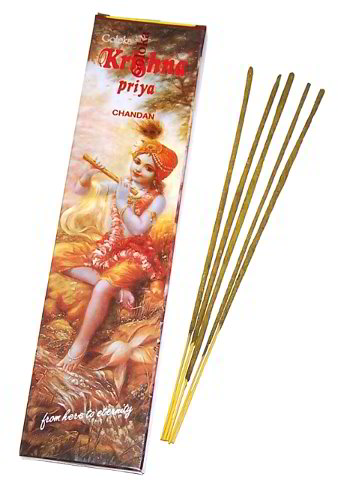Burning these again nearly three years later, and crude though the sticks are - poorly rolled, with some of the incense flaking off, quite thin and rather ugly looking, the aroma is quite pleasant. There is some benzoin on the stick, and when burned, the aroma is gorgeous blend of sandalwood and violets. There is much going on, and the aroma is very inviting, and quite exciting with its deep musky tones balancing against the nippy citric edge of the violet and benzoin. It's an aroma you want to keep on going because there is much to enjoy here, and it is never heavy, over bearing or harsh.
Date: Jan, 2016 Score: 36
Date: Jan, 2016 Score: 36
 |
| First review |
Attractive oblong box of hand rolled sticks by Goloka - the Bangalore based, non-profit charity which provides
food and education for disadvantaged children, and training and
assistance for women who have lost their husbands.. Bought online from Tribes & Vines for £1.45, post free [2024 comment: no longer available from Tribes & Vines - but Ephra World has it for 1.75 Euros].
The name Krishna Priya means "beloved of Krishna", and is usually applied to a woman or girl that Krishna was interested in. The box has an image of a young person, possibly a girl, playing a flute, and I assume this is a girl that Krishna fancies, rather than it being a drawing of young Krishna himself. The words "from here to eternity" are written across the bottom. The sticks are hand rolled - quite thin and rough, and then dipped in a yellow dusting of perfume. The bamboo stick is pale yellow - possibly dyed. The aroma is sweet and quite pleasant - some parma violets, nag champa, mint, and sandalwood. However, these do appear to be roughly made on a budget - the length and width of the bamboo sticks vary, sometimes so thin they are unable to remain upright unsupported; the incense paste is sometimes applied so thinly that the sticks burn so quickly, they are gone before the scent has really made an impression.
The name Krishna Priya means "beloved of Krishna", and is usually applied to a woman or girl that Krishna was interested in. The box has an image of a young person, possibly a girl, playing a flute, and I assume this is a girl that Krishna fancies, rather than it being a drawing of young Krishna himself. The words "from here to eternity" are written across the bottom. The sticks are hand rolled - quite thin and rough, and then dipped in a yellow dusting of perfume. The bamboo stick is pale yellow - possibly dyed. The aroma is sweet and quite pleasant - some parma violets, nag champa, mint, and sandalwood. However, these do appear to be roughly made on a budget - the length and width of the bamboo sticks vary, sometimes so thin they are unable to remain upright unsupported; the incense paste is sometimes applied so thinly that the sticks burn so quickly, they are gone before the scent has really made an impression.
I like the scent, though at times there is so little smoke and aroma, that the scent can hardly be noticed. Added to which, while it is sandalwood based, it leans rather more toward sweet nag champa with bergamont and violets than a decent solid sandalwood scent. I do think that if a company is calling a scent "sandalwood", that that scent should be dominant. If this was called simply "Krishna Priya", then the amount of sandalwood wouldn't be an issue.





























































































